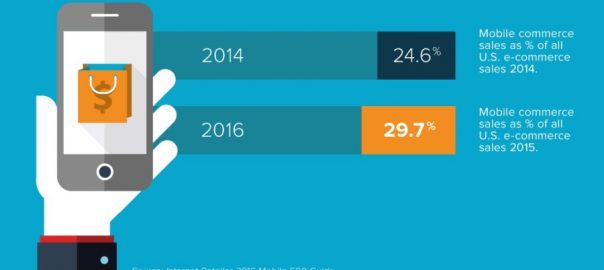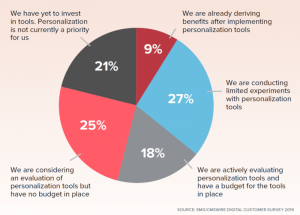A 2015 study by the Pew Research Center found that 64% of American adults own a smartphone — an increase of nearly 30% in merely four years. And, though not terribly surprising, the study also found that smartphone ownership is especially high among young Americans and those with high income and education levels (the traditional sweet spots for marketers).
Mobile Marketing Trends: What Percentage of Traffic is Mobile Anyway?
A 2015 report by eMarketer revealed that the time spent per day by American adults on mobile now exceeds desktop by nearly 30 minutes (2:51 to 2:22).
When you pair mobile marketing trends with the fact that eCommerce sales — and, more specifically, mobile commerce sales — are rising rapidly, it generates well-deserved momentum for the “mobile first” movement. According to Internet Retailer’s 2016 Mobile 500 Guide, mobile commerce sales topped $ 104 billion in 2015 and grew 2.58 times faster than total eCommerce sales.

Is Mobile Getting the Attention It Deserves?
All of that data points to a very simple truth: Mobile has fundamentally changed (and will continue to change) how, when, where, and why customers engage with and buy from your brand. To quote an epic 2015 mobile trends report from Forrester and Google:
We don’t “go online” anymore — we live online. Instant connectivity to people, objects, and ideas fosters the expectation that everything can and should be immediately available on a mobile screen.
Due to this new expectation (…) we now gravitate toward the online sources that provide the easiest-to-find answer, the payment app that sends money to friends within seconds, and the brand that is able to offer its wares in context and at our precise moment of need. Firms that fail to respond to this expectation will rapidly fall behind firms that do respond.
With a statement like that from brands like Google and Forrester, you’d think most marketers — and marketing technology vendors — would be treating mobile like a first-class citizen. Unfortunately, that’s not what’s happening.
Why Some Cross-Platform Strategies Fail
Too often, we see marketing technology vendors treat mobile like a second-rate platform — a development afterthought with web-based interfaces slapped into a mobile app so those vendors can say they’re “cross-platform.”
The problem? That approach creates a terrible customer experience.
Mobile is a philosophically different platform. It deals with installed, native apps, not a web of links. Because of that, you can’t treat mobile and web-based products the same way. They’re fundamentally different and require fundamentally different development.
This haphazard approach to mobile is particularly common in the referral marketing industry, which isn’t all that shocking when you know this industry’s history. When referral marketing first formed as a category, it was a variant of affiliate marketing — a web-based tactic that heavily relied on networks of links to drive traffic. When affiliate marketing vendors morphed into referral marketing companies (or new vendors copied the affiliate playbook), they repackaged the same bag of tricks.
That was fine in 2011 when Americans spent just 48 minutes a day on their mobile device and mobile commerce was virtually non-existent. In 2016, with mobile being a critical part of both the B2B and B2C buyer’s journey, embedding web widgets into a mobile product and calling the technology “cross-platform” isn’t cutting it.
4 Reasons a True Cross-Platform Approach is Critical
Ultimately, for a mobile experience to meet the needs of both end users and the companies they’re interacting with, it needs to be unique and dynamic. The mobile experience should be tailored to that specific platform and possess true cross-platform flexibility — allowing users to move smoothly and seamlessly between desktop and mobile devices.
Here are four reasons why that’s so important:
- Tracking is completely different on mobile platforms. The traditional gold standard of affiliate tracking — cookies — aren’t a viable option on mobile. Even if you manage to cookie someone in a mobile browser, those cookies are almost always sandboxed outside of native apps. You can’t get at them inside apps, so you can’t use them to track. You also can’t simply throw query parameters on your app store links and expect to access them in your app once it’s downloaded like you might do on the web. You’re going to need some special sauce to get you there.
- Native mobile apps feel much different than mobile websites or an “app” that lives in a mobile browser. Mobile devices aren’t as powerful as desktop computers and only a fraction of mobile computing power can be tapped into inside a browser or web-based view. As a result, web-based mobile experiences often feel significantly less polished. By contrast, native apps take full advantage of the mobile device’s capabilities, which provides a smooth and rich experience.
- First-class support for mobile means taking full advantage of the platform’s sharing abilities. Email and SMS are the two highest-performing referral channels and the address book is the key to getting people to use them. Without that, you’re left with a clunky experience that, in turn, leads to low participation. A true native mobile experience allows you to take full advantage of integrations to provide the best sharing experience possible. This empowers users to pull up their address book with a single tap and easily choose who to share their referral link with, which leads to higher participation, more shares, more clicks, and ultimately more referrals.
- Universal links are a must. No one is going to share or click on separate links based on the platform they’re using or whether or not they have an app installed. Users shouldn’t have to copy and paste codes to make sure they get a discount or their friend gets credit for referring them. This isn’t a realistic expectation of consumers. They deserve a single link to share and click that intelligently adapts to their situation and platform without the added hassle.
Customer Experience Matters
In order for brands to deliver innovative and custom experiences across touchpoints and channels, they need to make mobile UX a priority. It is very easy to claim mobile capabilities without actually having a true mobile experience, and in today’s cross-channel world that’s not going to cut it. If you want to build the best relationships with your customers and prospects, make sure your referral marketing vendor is able to provide a seamless experience across all channels.
Business & Finance Articles on Business 2 Community(68)









